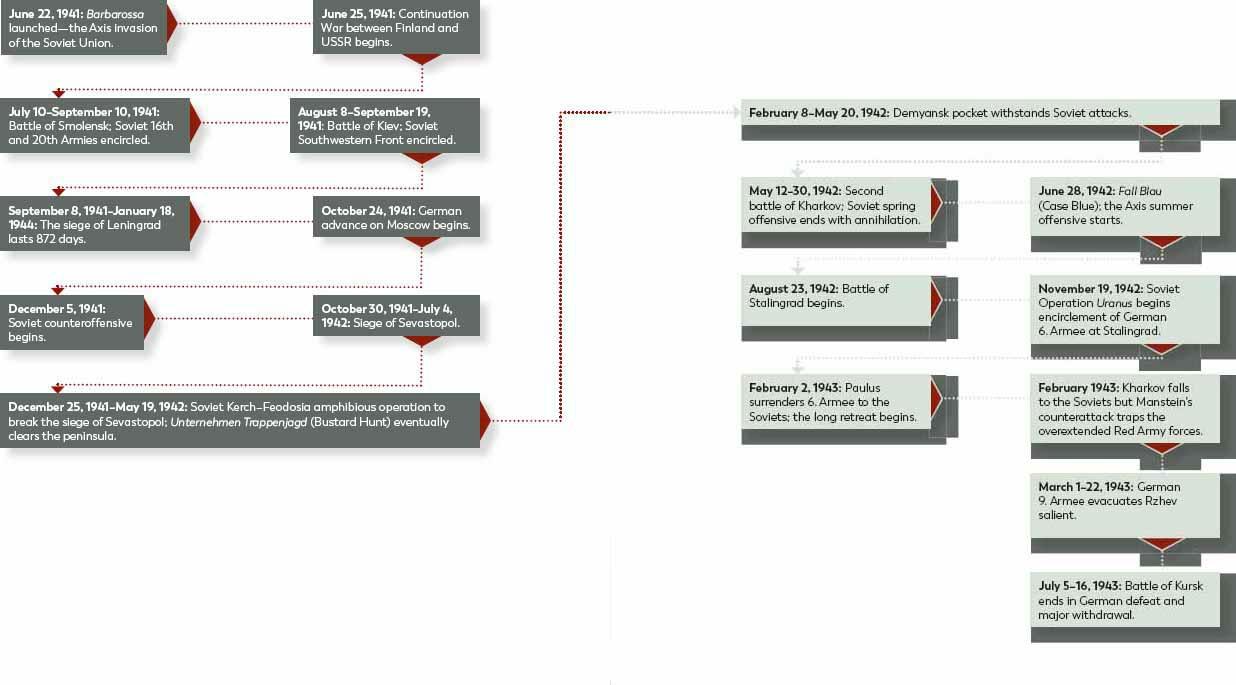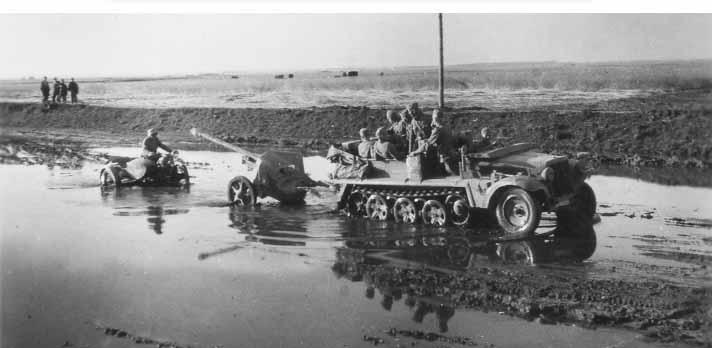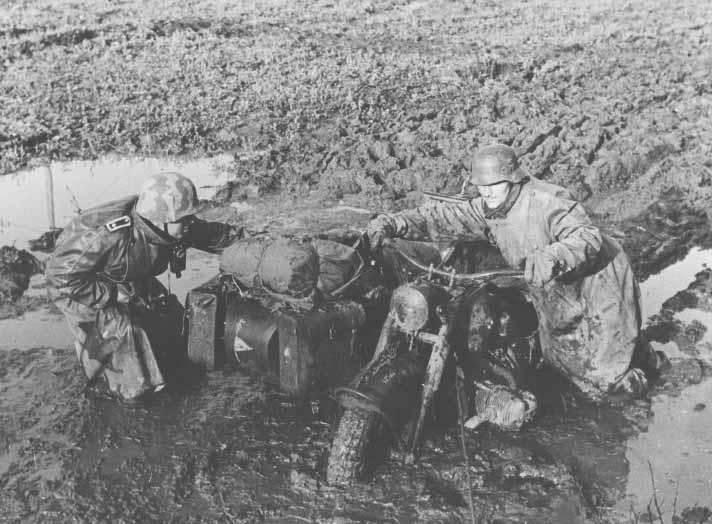Introduction
In the decades since the end of the war the German infantryman and his weaponry a well-covered subject has taken on almost mythical status. Even in defeat the German soldier is seen as a robust and cunning enemy beaten more by the numbers and firepower of the Allies than any failings of his own. This is a view reinforced and perpetuated by the influential postwar memoirs of various German commanders who were always more prepared to suggest that strategic defeat was in the face of their own tactical supremacy than accept their own errors or the accomplishments of their enemies.
Hitler’s plans towards the east may not have been immediately apparent as Germany signed the Nazi-Soviet nonaggression pact, invaded and split Poland between them, and then attacked westwards. However, a quick look at Mein Kampf shows his views on the Soviet Union and its people: “common bloodstained criminals,” “ the scum of humanity,” which “has exercised the most frightful regime of tyranny of all time. … We must not forget that the international Jew, who today rules Russia absolutely, sees in Germany, not an ally, but a State marked for the same destiny.” The Nazis thought that the only way for Germany to survive was to expand eastwards, populate the lands they captured, and either work the people they captured to death or expel them farther eastwards.
The economic exploitation of Soviet resources agricultural produce and labor was always part of the Nazi creed and the consequent deaths that would result were not considered reason to stop. Hitler expected his troops to be brutal, to extirpate resistance military or civil without compunction, and to mercillessly kill entire populations of whole districts in retaliation for
partisan attacks. On the other hand, military authorities made it clear that crimes committed by German soldiers were not to be punished if they claimed to have ideological considerations as their motive. This was an open invitation for soldiers to behave brutally. And they did. Whether towards the obvious primary enemy, the Russian soldier, or towards the Soviet Union’s many Jews, the German Army was directly involved in Nazi genocide assisting the four SS-Einsatzgruppen (task forces) A, B, C, D that followed them. The units were mainly SS, police, and auxiliaries from the local population. By the end of 1941, within the areas of the Soviet Union conquered by the Nazis, about half a million Jews had been murdered and between July and October 1941 as many as 600,000 POWs in Wehrmacht custody had been turned over to the SS to be killed. Those Soviet POWs who weren’t shot were starved and worked or walked to death. The wounded were often shot on the spot.
Between 1941 and 1945 more than half the Soviet POWs (possibly as many as 3.3 million of 5.7 million) taken by the Germans died in captivity, many in concentration camps. German generals expected this. General Erich Hoepner:
The objective of this battle must be the destruction of present-day Russia and it must therefore be conducted with unprecedented severity. Every military action must be guided in planning and execution by an iron will to exterminate the enemy mercilessly and totally. In particular, no adherents of the present Russian-Bolshevik system are to be spared.
There were differences of opinion, however. General Joachim Lemelsen, commander of XLVII. Panzerkorps, wrote:
This is murder! … The instruction of the Führer calls for ruthless action against Bolshevism (political commissars) and any kind of partisan! People who have been clearly identified as such should be taken aside and shot only by order of an officer … A Russian soldier who has been taken prisoner while wearing a uniform after he put up a brave fight, has a right to decent treatment.
The Barbarossa Decree of May
13, 1941
The Decree on the Jurisdiction of Martial Law and on Special Measures of the Troops was signed by Hitler’s chief of staff on the OKW, Wilhelm Keitel. It covered the “Treatment of criminal acts committed by enemy civilians” and said that “Criminal acts committed by enemy civilians are withdrawn from the jurisdiction of courts martial and summary courts until further notice;” that “Partisans and guerrilla fighters must be mercilessly destroyed by the troops in battle or in pursuit;” and that “All other attacks by enemy civilians against the Wehrmacht, its members and service personnel must also be repelled by the troops on the spot by the most extreme measures up to the destruction of the attackers.” As far as the treatment of criminal acts committed by members of the Wehrmacht and its service personnel against the local population, the decree said, “Prosecution for actions committed by members of the Wehrmacht and its service personnel against enemy civilians is not necessary even if these actions constitute a military crime or offense.” It was, for the ordinary infantrymen, a license to kill indiscriminately.

Partisans often just civilians rounded up as reprisals for partisan action—were killed indiscriminately by German soldiers.
On June 22, 1941, Hitler broke the Nazi-Soviet nonaggression pact signed in August 1939 and Germany invaded the Soviet Union. Everything seemed to proceed brilliantly as huge encirclement battles saw massive numbers of Soviet soldiers captured and their equipment destroyed or gained. The only niggle was timescale. Far from being over before winter, the German attacks bogged down in autumn mud thus giving the Soviets the time they needed to construct new defenses. This meant that when the frost hardened the ground sufficiently to allow the panzers to attack again, from November 14, the way to Moscow was barred.
While they had coped with the hot summer and disagreeable dust storms, the Germans didn’t handle a Soviet winter very well and didn’t know as much about the Soviet Union as they should have. For example, the Germans hadn’t studied the reports of combat between Allies and the Soviets in the winter of 1918–19 when all the problems they would encounter had been identified. Indeed, before 1941 the German General Staff had never been interested in the history of wars in Northern and Eastern Europe.
The older generation had been brought up in the tradition of von Moltke who considered it sufficient to study the countries immediately surrounding Germany … the northern regions of Europe remained practically unknown to the German soldier.
The resulting lack of awareness led to German soldiers suffering in the winter of 1941–42 and ultimately contributed to the failure of Barbarossa. In October and November 1941, the rasputitsa muddy season following heavy rains paralyzed the German logistical system, which was predicated on transporting supplies from railheads by trucks or horse-drawn vehicles. Five weeks elapsed before the going became firm enough for wheeled vehicles and the panzers.
Buoyed by the successes of 1939–41, Hitler and his generals had expected victory by the autumn, thus allowing many divisions to be sent
elsewhere. The fact that the German Army was sitting in snow without winter clothing, which was in depots to the west, forced the Nazi Party to aim its Christmas drive at German civilians to collect winter clothes and skis for the front. Until they arrived in February 1942, German troops had to take clothes from corpses, and improvise with devastating consequences. Everyone agrees about weather conditions in the east in October 1941, but there are conflicting accounts of the temperatures after that.
Maps and Mapping
Another factor that was to handicap the Germans was their lack of accurate information on the terrain. In Western Europe the Wehrmacht had fought over ground familiar to many of its commanders and well covered by accurate and detailed maps. Russia, however, was generally a great unknown. GFM (Generalfeldmarschall) Gerd von Rundstedt had this to say about the lack of accurate information: “I realized soon after the attack was begun that everything that had been written about Russia was nonsense. The maps we were given were all wrong. The roads that were marked nice and red and thick on a map turned out to be tracks, and what were tracks on the map became firstclass roads. Even railways which were to be used by us simply didn’t exist. Or a map would indicate that there was nothing in the area, and suddenly we would be confronted with an Americantype town, with factory buildings and all the rest of it.”

Extreme cold meant starting and maintaining vehicles was a nightmare particularly tracked and halftracked vehicles. The German Schachtellaufwerk system of interweaved and overlapping wheels provided better load spread and so lower ground pressure and a better ride but it wasn’t easy to maintain, especially when jammed with frozen snow or mud. One of a series of watercolors of XXXXVII.
Panzerkorps in the east by Fritz Brauner, an Obergefreiter in Flakregiment 101. RCT
Rasputitsa the mud made the going impossible for motorized troops and stopped the German advance in its tracks. NAC
Fighting in the Russian Winter
The results of the decision to fight around Moscow without appropriate clothing and provisions highlighted the overoptimism of Hitler and the German planners. The lessons learned were identified in a series of U.S. Army pamphlets in the 1950s, most authored by high-ranking German sources:
•
Mobility and logistical support were restricted because roads and runways could only be kept open by ploughing or compacting the snow. Cross-country transport if possible, at all required wide-tracked vehicles or sleds. Infantrymen
•
•
•
Human efficiency and survival required adequate shelter. If not available locally, portable shelter had to be provided. Frostbite casualties exceeded battle losses unless troops wore proper clothing, including warm gloves and footgear. 6. Panzer-Division was reporting about 800 frostbite casualties a day in late 1941 until its engineers blasted craters for all the combat elements. Three to five men clustered in each foxhole which was covered with lumber and heated with an open fire. Frostbite cases all but disappeared. Speedy removal of the wounded from the battlefield to shelter was essential to prevent even minor wounds from resulting in death from exposure.
The defensive was normally superior to the offensive because the attacker had to contend with debilitating exposure to frost and wind chill, exhaustion from moving through deep snow, relative lack of concealment, longer exposure to enemy fire because rushing was not feasible, and aggravated supply problems. Any offensive had to be limited in both time and distance and had to have prospects of securing shelter.
• moving through deep snow rapidly became exhausted. Extended marches required skis or at least snowshoes but the wrong snowshoes were virtually useless. Without special lubricants firearms and motors froze up and became inoperative at subzero temperatures. Motor vehicles were unreliable; native horse sleighs provided the most reliable transport. By 1942–43, the Germans ensured they had suitable lubricants, but starting motor vehicles was a constant problem. Towing badly damaged both motors and differentials. Applying heat by lighting fires under engines for up to two hours before moving helped, as did just leaving motors running.
Troops not acclimated to the harsh environment had less chance for survival. Appropriate clothes and boots were essential, and their use required supervision: long overcoats were not practical for long marches; camouflage required
•
•
white outer garments. Even though the temperature was very low, the sun’s ultraviolet rays were greatly magnified and caused severe sunburn.
The value of trained ski troops was underscored by their scarcity on both sides. The climate compounded distances. All deployments and maneuvers, especially cross-country, required extra time. Deep snow and ice complicated both retreat and pursuit. Where they had to cover open terrain in those operations, both sides found themselves in highly vulnerable positions. Movement over ice had to be considered carefully in an area of extreme cold but if thick enough, it offered an excellent route.
From 3 feet to 6 feet of snow nullified the killing power of small arms and when water was allowed to freeze over this, less thickness was needed. Deep snow reduced the effectiveness of mortar shells and low-caliber artillery and made the German 3.7cm and 5cm antitank artillery very difficult to use. During periods of extreme cold weapons formed a vapor when fired thus disclosing the shooting position. Almost anything warm breath, smoke from a fire, a weapon firing—also caused vapor which tended to hang over a position thus disclosing it.
•
•
Sound travels farther in very cold weather. The noise of troops advancing over heavy, crusted snow deprived them of the advantage of surprise. Canteens of water quickly froze if they were carried exposed. They had to be carried next to the body to keep from freezing and bursting. Charcoal was better than wood for heating because it created less smoke to reveal troop positions.
Men had to be made to relieve themselves daily or constipation set in (although some were relieved at this as it stopped the flux caused by dysentery). Thaw periods created the greatest danger from trench foot. Great care had to be taken by every leader to ensure men were taking the proper precautions to guard against this: dry socks and constant exercise of the feet.
• Frozen ground made field fortifications difficult to construct. Explosives were useful for constructing foxholes and larger shelters, without which the infantry were at the mercy of the cold and enemy artillery. Mines often failed in winter. This was true when the snow was sufficiently deep to cushion the fuse and when alternating melting and freezing created an ice bridge over the detonator.
Skis spread the load to allow easier transport of weapons over ice and snow. This one is a “Doorknocker” 3.7cm antitank gun, so called because it did little more than announce its presence when used against the heavy armor of the T-34 or KV series Soviet tanks. U.S. Army
Russia isn’t always frozen. Endless dusty marches in 1941 and the fertile cornfields of Ukraine in 1942 were features of the German summer advances. NAC
Generalfeldmarschall (GFM) Fedor von Bock, commander of Heeresgruppe Mitte, recorded in his war diary on November 5, 1941, a temperature of 29°C ( 20°F). Marshal Zhukov, in Moscow, said that during the November offensive the temperature remained stable at 7° to 10°C (+19° to +14°F). Other Soviet figures cite meteorological service records of the minimum temperatures for the Moscow area in late 1941 as being October, 8.2°C (about +17°F); November, 17.3°C (+1°F); and December, 28.8°C ( 20°F). There were also many reports of temperatures as low as 40° during that exceptionally cold winter, and at least one report of 53°C ( 63°F).
One thing that is agreed is that the heavy snow started in December just in time to help Heeresgruppe Mitte because the deep snow hindered the Soviet counteroffensive. The snow may have helped the Germans in the face of the Soviet counterattack, but the Ostheer suffered more than 734,000 casualties (about 23 percent of its average strength of 3,200,000 troops) during the first five months of the invasion, and on November 27, 1941, Generalmajor Eduard Wagner, the Generalquartiermeister im OKH (Quartermaster General of the German Army), reported that, “We are at the end of our resources in both personnel and materiel. We are about to be
confronted with the dangers of deep winter.”
By the turn of the year, they had suffered about 100,000 cases of frostbite, more than 14,000 of which required amputations. By the end of that terrible winter the number of frostbite victims exceeded a quarter of a million. To these must be added thousands of cases of pneumonia, influenza, and trench foot. The impact of those non-battle casualties made the disparity between the Germans and the Red Army more obvious. While the Soviets had lost millions in dead, wounded, and captured by December 1941, Russia was able to muster replacements from its vast manpower resources. In contrast, by November 26 German losses of about 375,000 dead, missing, and permanently disabled were virtually irreplaceable they were the veterans, the canny NCOs, and junior officers who had fought so well in the early years. By April 1942 the German deficiency on the Soviet front had reached 625,000 men.
The German replacement troops had to change to take into account conditions on the Eastern Front. The first adjustment saw the army revise the standards for selecting lower-echelon commanders. Their average age was lowered, and the physical fitness requirements were raised. For weeks at a time officers and men had no baggage, no change of clothes and no opportunity to change their underwear. This required another type of adjustment to the Russian way of life, if only to prevail in the struggle against filth and vermin. Many officers and men of the older age groups broke down or became sick and had to be replaced by younger men. Certainly, the Soviets were seemingly able to put up with more than their German counterparts.
Carrot and Stick
Morale is an important consideration in any army, and many methods are used to foster it. Among the “carrots” are decorations, which supply a tangible record of soldiers’ bravery and honor and are awarded by most armies. The photos of German soldiers on the Eastern Front show how important medals are. Few even in the dirtiest, hardest environments do not have their decorations visible, the most often seen being those that
•
•
•
Antiaircraft Flak Battle Badges for both Luftwaffe and Army (Flakkampfabzeichen der Luftwaffe/des Heeres), and the Ground Assault Badge of the Luftwaffe (Erdkampfabzeichen der Luftwaffe). The two Flak badges were awarded for action against aircraft, although the Luftwaffe’s was also for ground targets. The Ground Assault Badge of the Luftwaffe was instituted on March 31, 1942. Bandit-warfare Badge (Bandenkampfabzeichen) was awarded from January 29, 1944. There were three classes: bronze (20 combat days: 1,650 awarded), silver (50: 510) and gold (100: 47), ten of the latter being awarded in February and March 1945 to members of the 24.
Waffen-Gebirgs-(Karstjäger-) Division der SS.
Close Combat Clasp (Nahkampfspange): three grades: bronze for 15 battles, silver for 25, gold for 50+. The gold was highly regarded by soldiers and was bestowed personally by Hitler. Numbers issued: 36,400 bronze, 9,500 silver, and 631 gold. It was awarded in “recognition to the soldier who often engages in close man to man combat with weapon in hand and has proven his worth.”
• defined the infantryman: the Close Combat Clasp, General Assault Badge, Tank Destruction Badge, and Wound Badge. Below are the most often seen:
Eastern Front Medal (Medaille, Winterschlacht im Osten 1941/42).
Over 3 million were awarded “in recognition of proficiency in combat against the Bolshevik enemy and the Russian winter during the period November 15, 1941 to April 15, 1942.”
Franz Giesler was a highly decorated soldier who was awarded the Eisernes Kreuz (Iron Cross) I. Klasse on March 16, 1942, Deutsches Kreuz in Gold on May 28, 1944, as a Leutnant in 5./Grenadier-Regiment 457, and the Ritterkreuz on April 29, 1945, as a Hauptmann in I./Flak-Regiment 120 (although the latter medal wasn’t recognized). In this photo he wears the Ritterkreuz at his neck, the Eisernes Kreuz II. Klasse at the second buttonhole of his tunic and Deutsches Kreuz in Gold on his right breast pocket. Above his left breast pocket is the Nahkampfspange, below which he wears the Eisernes Kreuz I. Klasse, Infanterie-Sturmabzeichen and Verwundetenabzeichen. On his right arm he has two Sonderabzeichen für das Niederkämpfen von Panzerkampfwagen durch Einzelkämpfer. RCT

The Infantry Assault Badge in silver could be awarded to infantrymen and Gebirgsjäger. The bronze class was instituted for motorized infantry and the machine-gun, infantry gun, and antitank companies of infantry or Gebirgsjäger regiments. RCT
Eastern Front Medal and award notification, this one to Leutnant
Herbert Vögel of 2. Panzer-Aufklärungs-Abteilung. RCT
•
General Assault Badge (Allgemeines Sturmabzeichen): one grade; later (1943) adapted by adding a plate identifying 25, 50, 75, or 100 attacks. Over 460,000 awarded by divisional commanders to officers, non-commissioned officers and enlisted personnel who had been involved in three assaults or three different days of fighting “gun in hand”. Successful violent exploration as well as counterattacks also counted. Members of the artillery, tank destroyer teams and members of StuG batteries could also be awarded the medal.
German Army Parachutist Badge (Fallschirmschützen-Abzeichen des Heeres).
German Cross (Deutsches Kreuz): two grades, gold and silver.
Honor Roll Clasp of the Army (Ehrenblatt des Heeres). First issued in July 1941, the roll recorded the names of soldiers who had distinguished themselves in combat in an exceptional way. Until January 30, 1944, it was a paper award only. Four additional grades introduced on November 10, 1944, based on the number of combat






























